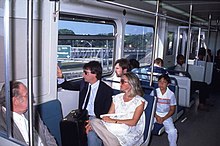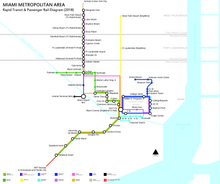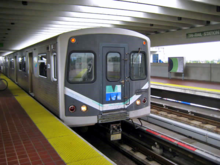
METRORail is the 22.7-mile (36.5 km) light rail system in Houston, Texas. In 2022, the system had a ridership of 12,176,700, or about 44,300 per weekday as of the third quarter of 2023. METRORail ranks as the second most-traveled light rail system in the Southern United States and the 12th most-traveled light rail system in the United States, and has the highest ridership per mile for light rail systems in the Southern US. METRORail is operated by the Metropolitan Transit Authority of Harris County (METRO).

Miami-Dade Transit (MDT) is the primary public transit authority of Miami, Florida and the greater Miami-Dade County area. It is the largest transit system in Florida and the 15th-largest transit system in the United States. As of 2022, the system has 60,734,900 rides per year, or about 248,700 per weekday in the third quarter of 2023. MDT operates the Metrobus with their paratransit STS systems run by LSF. MDT also operates two rail transit systems: Metrorail and Metromover.
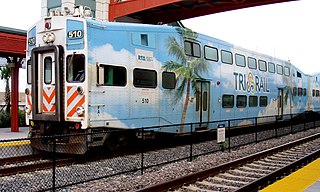
Tri-Rail is a commuter rail service linking Miami, Fort Lauderdale and West Palm Beach in Florida, United States. The Tri prefix in the name refers to the three counties served by the railroad: Palm Beach, Broward, and Miami-Dade. Tri-Rail is managed by the South Florida Regional Transportation Authority (SFRTA) along CSX Transportation's former Miami Subdivision; the line is now wholly owned by the Florida DOT. The 80.0-mile-long (128.7 km) system has 19 stations along the Southeast Florida coast, and connects directly to Amtrak at numerous stations, to Metrorail at the Tri-Rail and Metrorail Transfer station, Miami Intermodal Center, and MiamiCentral, and to Brightline at MiamiCentral.

Metromover is an automated people mover system operated by Miami-Dade Transit in Miami, Florida, United States. Metromover serves the Downtown Miami, Brickell, Park West and Arts & Entertainment District neighborhoods. Metromover connects directly with Metrorail at Government Center and Brickell stations. It also connects to Metrobus with dedicated bus loops at Government Center and Adrienne Arsht Center station. It originally began service to the Downtown/Inner Loop on April 17, 1986, and was later expanded with the Omni and Brickell Loop extensions on May 26, 1994.

Government Center station is an intermodal transit hub in the Government Center district of Downtown Miami, Florida. It is operated by Miami-Dade Transit and serves as a transfer station for the Metrorail and Metromover rapid transit systems and as a bus station for Metrobus, Paratransit, and Broward County Transit buses. MiamiCentral is directly connected via a pedestrian bridge over NW 3rd Street. The station is located near the intersection of Northwest First Street and First Avenue, a part of the Stephen P. Clark Government Center Building. It opened to service May 20, 1984, next to the site of a former FEC railway station which is now MiamiCentral.

Brickell station is a Metrorail rapid transit station in Miami, Florida, serving the system's Green and Orange Lines. One of the core stations of Miami's public transport network, it serves the financial district of Brickell. Combined, the Metrorail and Metromover station complex at Brickell sees roughly 8,430 boardings each weekday, making it the system's second-busiest station.

Dadeland South station is a transfer station on the Metrorail rapid transit system in the Dadeland district of Kendall, Florida. It is the southern terminus of the Metrorail system and the northern terminus of the South Dade TransitWay. It is the southernmost passenger rail station in the Continental United States. This station is located near the intersection of Dadeland Boulevard and Datran Boulevard, adjacent to South Dixie Highway, three blocks southwest of Kendall Drive and Dadeland Mall, and just east of the US 1–Palmetto Expressway junction. It opened to service May 20, 1984.

Miami Intermodal Center (MIC) is an intermodal rapid transit, commuter rail, intercity rail, local bus, and intercity bus transportation hub in Miami-Dade County, Florida, just outside the Miami city limits near the Grapeland Heights neighborhood. The facility was constructed by the Florida Department of Transportation and is owned by the Miami-Dade Expressway Authority.
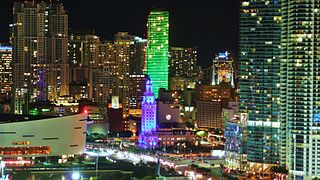
Downtown Miami is the urban city center of Miami, Florida, United States. The city's greater downtown region consists of the Central Business District, Brickell, the Historic District, Government Center, the Arts & Entertainment District, and Park West. It is divided by the Miami River and is bordered by Midtown Miami's Edgewater, and Wynwood sections to its north, Biscayne Bay to its east, the Health District and Overtown to its west, and Coconut Grove to its south.
Transportation in Florida includes a variety of options, including Interstate Highways, U.S. Highways, and Florida State Roads; Amtrak and commuter rail services; airports, public transportation, and sea ports, in a number of the state's counties and regions.

Dadeland is a commercial district and urban neighborhood similar to an edge city, amid the sprawling metropolitan Miami suburbs of Kendall, Glenvar Heights, and Pinecrest, in the U.S. state of Florida, at the end of the Metrorail line.

The Arts & Entertainment District, or previously known as Omni, is a neighborhood of Downtown Miami, Florida. It is bound roughly by North 19th Street to the north, North 10th Street to the south, North West 2nd Avenue to the west, and Biscayne Boulevard to the east.

The Greater Miami area, composed of the three counties of Miami-Dade, Broward, and Palm Beach, also known collectively as South Florida, is home to a wide variety of public and private transportation systems. These include heavy rail mass transit (Metrorail), commuter rail (Tri-Rail), automated guideway transit (Metromover), highways, two major airports and seaports, as well as three county-wide bus networks, which cover the entire urbanized area of South Florida. Census and ridership data show that Miami has the highest public transportation usage of any city in Florida, as about 17% of Miamians use public transportation on a regular basis, compared to about 4% of commuters in the South Florida metropolitan area. The majority of public transportation in Miami is operated by Miami-Dade Transit (MDT), which is currently the largest transit system in Florida and was the 14th largest transit system in the United States in 2011.
BayLink is a long-proposed transit connection between Miami and Miami Beach, Florida. Proposals have ranged from streetcar, light rail, monorail, Metromover, or Metrorail extension that would connect Downtown Miami to South Beach via the MacArthur Causeway, with the light rail or streetcar options potentially having loops at both ends. In 2020, the project was previously approved by commissioners as Miami Beach Monorail, a $770 million public-private partnership project connecting 5th Street in South Beach to Metromover on the mainland at the Genting property in Omni. In November 2022, the project would be changed to Metromover because the budget did not allow for the proposed monorail and it would not provide a one-seat ride from Downtown Miami to South Beach.

The Metrobus network provides bus service throughout Miami-Dade County 365 days a year, operated by Miami-Dade Transit. It consists of about 93 routes and 893 buses, which connect most points in the county and part of southern Broward County as well. As of 2022, the system has 41,854,200 rides per year, or about 175,600 per day in the third quarter of 2023.

The Underline is a 10-mile linear park being developed in Miami-Dade County, Florida. When complete, it will run underneath the county's elevated Metrorail system from the Miami River near Brickell to the Metrorail's southern terminus at Dadeland South. The project is essentially upgrading a pre-existing bike path, known as the M-Path, into a full linear park. As of 2022, the first phase of the Underline is complete in the Brickell area. The second phase, which will run from Brickell to just south of Vizcaya station, is set to be complete in December 2023. The full park will be complete in fall of 2026.
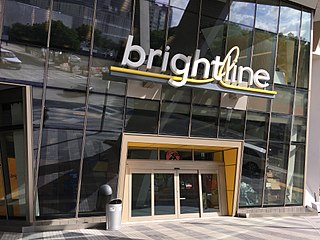
MiamiCentral is a train station in Miami, Florida. Located in Downtown Miami, the station provides access to Brightline inter-city rail service and Tri-Rail commuter rail service. The station is part of a 9-acre (3.6 ha) mixed-use complex, which includes 3 million square feet (280,000 m2) of residential, office, commercial, and retail development.






